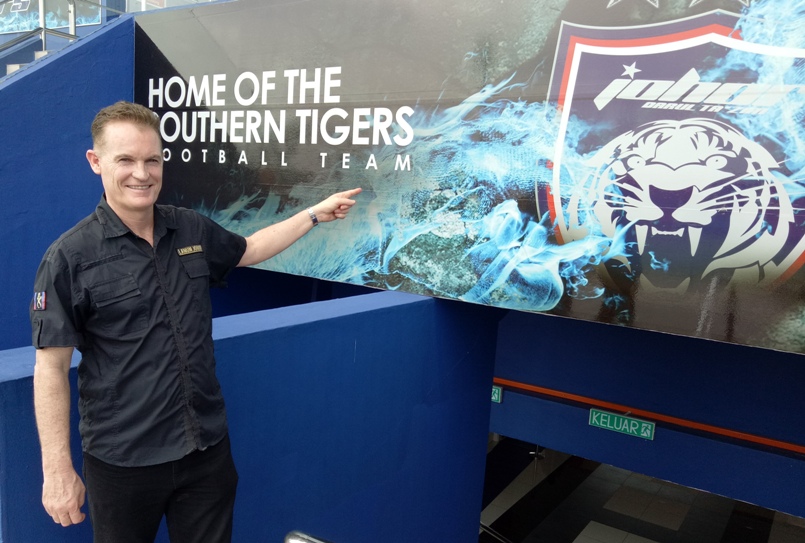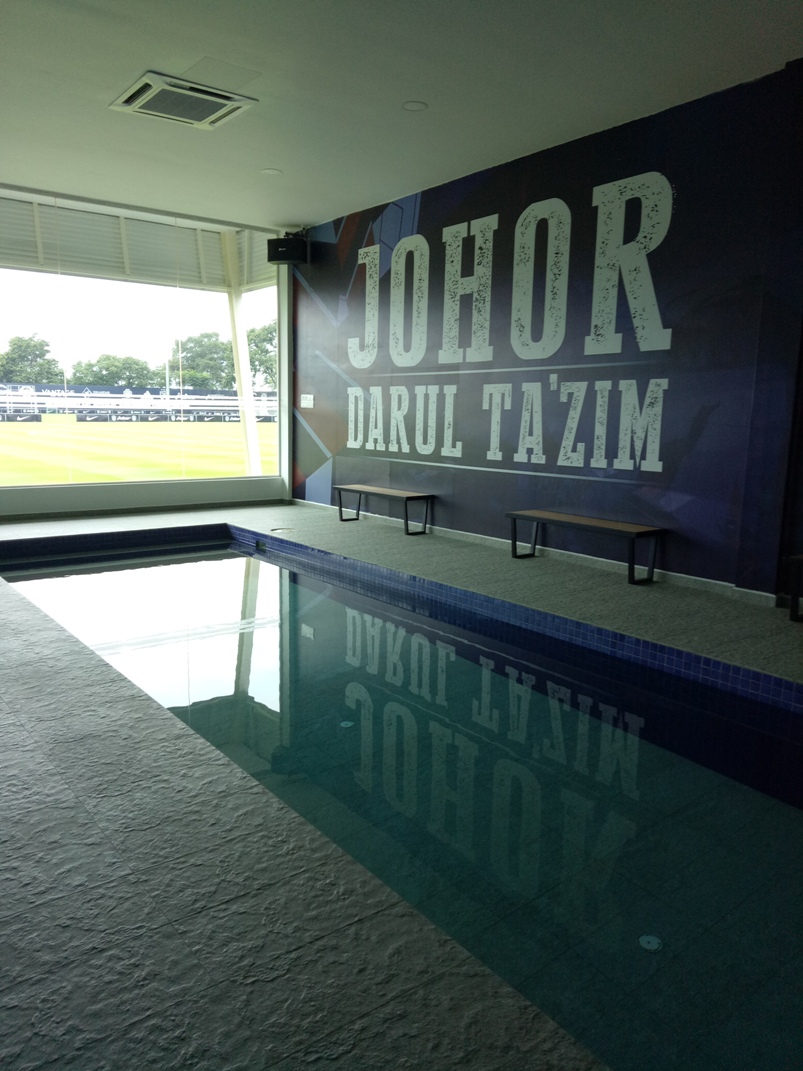
By Suresh Nair
THE rising football fairy-tale of Johor Darul Ta’zim FC (JDT) can be summed up in a 15-letter word: Professionalism.
In JDT Sporting Director Alistair Edwards’ rousing words: Train like a professional. Eat like a professional. Drink like a professional. Tweet like a professional.
This is the second part of a three-part series on Malaysia’s fastest-rising football club to highlight that the mindset of a professional is as important to building a world-class football infrastructure of state-of-the-arts facilities.
During the recent three-hour visit to JDT, with former Singapore award-winning coach Jita Singh, Edwards critically showed that the high-end degree of professionalism is clear to see at the new training facility Padang Sri Gelam, which must rank as the “jewel” of a state-of-the-art training ground, over 8,000 square metre training vicinity.
Hats off to the JDT that it’s a unique one-of-a-kind landmark infrastruture: The first world-class football training facility ever built in Malaysia and the first of its kind in South-east Asia.
Besides the indoor synthetic field measuring 16m by 109.2m, the high-tech sports building comes with the latest gym equipment, a swimming pool and ice baths similar to those available at the biggest European clubs for the players’ usage.
This is perfectly tuned in line to the vision of HRH Tunku Ismail Ibni Sultan Ibrahim, the football-fanatic Crown Prince of Johor, who wants international-level training equipment for the players and to help those who are injured to recover faster.
“The training pitch and overall infrastructure is compatible with the highest of FIFA requirements. This is a special gift by Tunku Ismail (or Tunku Mahkota Johor, TMJ, as he is known across the Causeway), to the younger generation of Johorean players to reach global standards,” said Edwards.
It was named Dato Suleiman Mohd Noor Indoor Training Centre as a special recognition and appreciation for his contribution as the “Father of Johor Football” in February 2016. It was officially opened on April 21 2016.
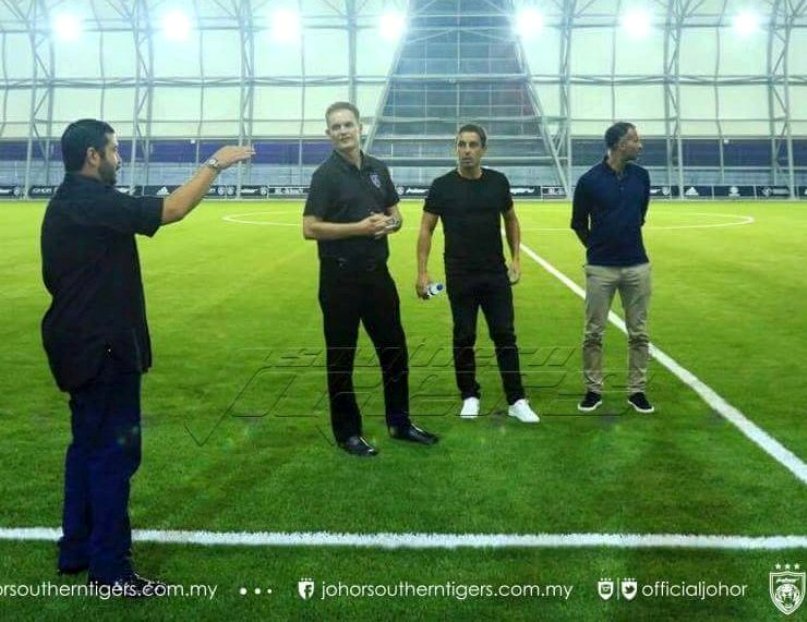
ROLE-MODEL EXAMPLE
Edwards says: “A top club needs a top academy. This will allow JDT to attract more high-profile talents from around Malaysia to our academy because the younger players know they can develop to their best potential with state-of-the-arts facilities. It’s just like going to a top university for your education.”
The former Australian striker, who played when Johor won the “double” in the 1991 season, spells out that great footballers don’t just appear from nowhere, as if by magic. The best players in the world, whether it’s Lionel Messi, Gareth Bale, Neymar or Cristiano Ronaldo, played football from a very young age and then learned the finer points of football at a professional soccer academy.
Taking plenty of leafs from the best clubs in the world and bringing the technical and tactical know-how to Malaysia is one of Edwards’ ambitious visions in order to fire up JDT as the role-model example, not only for Malaysia, but also South-east Asia.
Edwards has an AFC/FFA Advanced Licence Coach Instructor and has conducted numerous Advanced Pathway coaching courses for the FFA (Football Federation of Australia) and the AFC. In August 2009, he was appointed to the position of FFA Assistant Technical Director, working alongside Dutchman Han Berger.
His dual role at the FFA included the assistant coach role to the Young Socceroos where he worked alongside Jan Verslijen, he then progressed to the head coach role of the Under-17 team, the ‘Joeys’. Edwards had earlier coached at two FIFA Under-20 World Championships with the ‘Young Matildas’.
Edwards cites, for example, the Real Madrid City, which in 2005, built what he calls the “the greatest sporting facility ever built by a football club”. The project was designed by legendary architects Carlos Lamela and Emilio Butragueño.
The complex is situated in one of the most promising areas for the future of the city of Madrid, the Valdebebas Park, the largest urban development project in the history of the community of Madrid and one of the green areas that will help the city to breathe in the future. It covers approximately 1,067 hectares of land and is a short distance from the nearby Terminal 4 of Madrid-Barajas Airport, which was opened a few months after the Real Madrid City.
Mind you, the complex has an area of 1,200,000 m2. It is 10 times bigger than the old Real Madrid Sports City, 40 times bigger than the Santiago Bernabéu, 16 times bigger than Red Square in Moscow, 2.7 times bigger than the Vatican City and 1.6 times bigger than the Forbidden City in Beijing.
JDT has infused a number of the world-class infrastruture ideas from TMJ’s visits to the top European clubs to Johor, especially with the training facility at Padang Seri Gelam, with the latest and most high-tech equipment, to get the players to rise to the big occasion.
Towards the mission and vision of JDT, to have the best facilities and infrastructure in South-east Asia, this facility has state-of-the-art dressing rooms, gymnasiums, classrooms, conference rooms, offices, hydrotherapy pools and medical centre and even a media area.
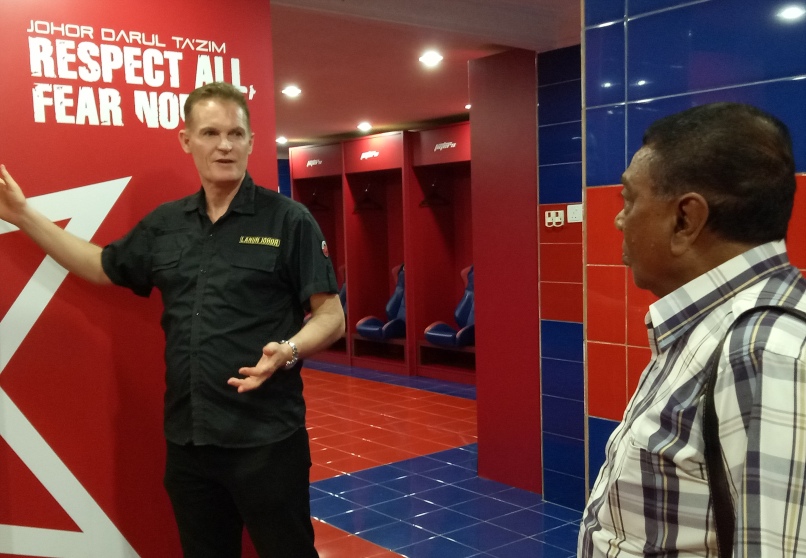
REGIONAL TOURIST DESTINATION
“We will build, starting with Padang Seri Gelam, in humble ways something similar to the sports complex at Real Madrid with the forefront of world training facilities,” says Edwards. “And when the new ‘football city’ complex, at Iskandar Puteri, to be ready in 2019, we hope to make it to a regional tourist destination for football.”
Edwards reiterated that the TMJ’s father, the Sultan of Johor, will have his name enshrined at the new RM400 million stadium as the Sultan Ibrahim Larkin Stadium in honour of his behind-the-scenes inspiration to Johor football.
The new stadium is being built in the western outskirts of Johor Bahru, in the newly created luxurious Iskandar Puteri district in a development area covering a 11ha-site, that will include the sports stadium with hotels, apartments, shopping malls, rugby, tennis and futsal facilities.
Edwards says: “The new stadium would address any shortcomings in the older stadium in Larkin. The plan is to house the main JDT team at the new stadium and move the JDT 2 team to the stadium in Larkin. The JDT 3 and JDT 4 teams will then use the Pasir Gudang Stadium for their needs.”
Another world-branded club JDT wants to emulate is very close to Edwards’ heart: Bayern Munich, where excellence is no accident and the German giant has set the distinct global standard in total player development.
It comes as no surprise that Bayern, a club that boasts a rich history of success on the field at the senior level, understands the intricacies of building from the ground-up. The development that takes place at the Säbener Strasse youth academy extends far beyond football drills. At any given time, the Bayern academy has approximately 170-190 players in the youth programme.
“Just look at Bayern, a club that has produced the likes of Bastian Schweinsteiger, Markus Babbel, Holger Badstuber, Dietmar Hamann, Philipp Lahm, Mats Hummels, Toni Kroos, Thomas Müller, Emre Can and David Alaba. They’ve the championship mentality because they’ve been the most successful club domestically whilst providing the bulk of the talent in the national side ranks at every age group,” says Edwards, who was the former Australian assistant technical director.

YOUTH DEVELOPMENT
“We want to be like a club like Bayern, particularly in youth development. In football, it’s not about egos, it’s about success. We believe, even in Asean, we must think big and harbouring world-class dreams must be our benchmark.
“Based on my experience, Malaysian football needs to grasp very quickly that we simply cannot use the traditional outdated approach when it comes to dealing with player and coach development. Globally, the game continues to move forward, the Asian Champions League is huge now and the AFC Cup is growing from strength to strength. These competitions weren’t around when I was playing in the 1990s and they are now the pinnacle of where the best players, coaches and teams want to play.
Unfortunately in Malaysia, such tournaments as the Suzuki Cup, that aren’t even scheduled into the FIFA window appear to be the benchmark of aspirations that drives policy. It’s this type of traditional thinking that has caused the unnecessary friction between JDT and the national body. TMJ is thinking and moving forward with a global focus, a mindset similar to the progressive football nations of Japan and Australia, while in Malaysia the fixed, traditional mindset is holding back progress.
He cites Bayern Munich’s philosophy, which typifies qualities like excellence, perfection, attention to detail, unity, diversity and innovation. The club motto, Mia san Mia, translates to ‘We are who we are’ and in football, there is perhaps no greater truth.
“We must learn from the best in grooming the future players and coaches,” says Edwards. “Teams, players and coaches are defined by style but ultimately remembered by results. Bayern’s dominance starts from the ground work at the academy. In 1995, Karl-Heinz Rumminegge and Uli Hoeness set out to restructure the standard of football played at Bayern Munich and in doing so came to the prophetic realisation that the best academies in the world train their core players instead of just buying new ones.”
Learning from Bayern Munich, Real Madrid and Manchester City, Edwards says he realises that two defining principles have both allowed these European giants to not only rise to the top, but stay there as well.
“The first concept was fiscal responsibility,” says Edwards. “It simply makes better business sense to develop talent rather than depend on development schemes and systems from other clubs to create a player that fit the club’s needs.
“Secondly, they realised that to dominate domestic and European football, it needed players who were groomed to be technically and tactically adept while playing the Bayern Munich way. It means living and breathing the club’s tradition, philosophy, and mentality on and off the pitch.”
The new era of youth development at Bayern is the culmination of some of the best coaches, technical directors, and players in German football, something he wants to push seriously at JDT.
In the early-2000s, when German football hit rock bottom and revamped its national programme and initiative, Bayern Munich’s director of youth football, Werner Kern, was not shy in his vision for establishing one of the best football academies in the world: “In order to establish the best football education it must have the best of everything: the best coaches, the best team environment, the best age-oriented challenges, the best training conditions and equipment.”
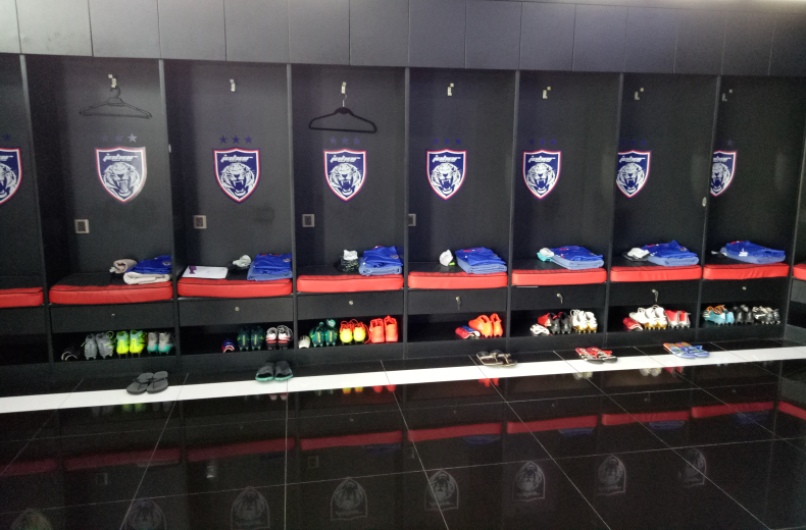
GO FOR THE YOUNG
Edwards, who believes like the Johor Prince, in the values of youth development says that serious spadework must be done with the younger generation.
“Let them at six, eight, nine or 10 years of age enjoy the magic of football. We don’t specifically test any technical skills – no one has to go dribbling through cones. We just let the kids play, with or without a goalkeeper, without a dead-ball line – just like it is in the streets. There is nothing to win and there are no trophies to hand out. Fun, emotion and desire are the only things that matter,” says Edwards.
In his words, players at the JDT Academy must play “age-appropriate football”. The youngest groups, Under-7 to Under-10, play on condensed pitches in seven-a-side formations. Goalkeepers must be encouraged to play in small-sided matches to increase their technical proficiency and confidence with the ball at their feet. To create complete players, youngsters are made to play a variety of positions while learning the fundamentals of the game well before any tactical implementation takes place.
He believes JDT players must learn to appreciate possession-based football and constant movement must be the primary standard. He adds: “The barometer for quality is seldom the score line, but rather the style and fluidity of the football on display. Efficiency is trained into the players to eliminate needless and reckless running.
“The team operates as a unit as players understand their role is to serve the team over themselves. Effective possession is the key to our philosophy and when we lose the ball, we want it back as soon a possible.”
Edwards says just as ball-circulation has become a staple of Bayern Munich and Real Madrid’s football, and possession must be inculcated to be the team’s best form of defence and attack. “When the ball is lost, the team presses to recover possession and begins circulating the ball and probing for attacking opportunities,” he says.
In Edwards’JDT books, training is age-specific but the competition for the young sides is often against older teams to provide a comprehensive and challenging competitive environment for players in the youth system to compete against each year.
Another aspect is the hyper-organisation and like the Bayern Munich example, the need to categorise players in a multitude of competencies. Players are identified as leaders, role players (who can play a variety of positions with proficiency), and squad players. Part of the categorising exercise is to assess the targeted growth plans for each age division, each position, and as an individual – all while using one system of play consistent with the senior team so there are no surprises when players are integrated into the first team.
“There’re no short cuts to success,” says Edwards. “We intend to develop at JDT a consistent approach that ensures complete and holistic development. A player who falls short of being able to excel in his development will likely not succeed at JDT, however, that player may be successful elsewhere, which is a salute-success for the club, too.”
Professionalism is, yet again, the key word in Edwards’ dictionary and he believes the meticulous long-term approach led by the Prince also guarantees players are part of the machine. He explains: “Players fit the system. The system does not fit the player. As such, individualised coaching is provided for each player as they are ultimately investments.
THE RIGHT COACHES
“We encourage coaches to analyse character, football ability, capacity to learn complex systems of play, growth potential, the ability to handle difficulty while absorbing skills, honing technique, and maximising a player’s mental and athletic output. Part of the evaluation process is personality testing where players are assessed in areas including confidence, sensitivity, arrogance and humility.”
Edwards says that TMJ wants more youngsters to believe football as a longer-term career. He says: “TMJ is building a great football club with the state-of-the-arts world-class facilities. My message to them: They need to take a chance, don’t be scared and go for it. They’ve got to be fully involved, and they will improve day-by-day and have to integrate as a united and disciplined team.”
Indeed, Edwards’ dream is to have at JDT the best football academy in Asean by 2020.
And at the rate he’s working with the great leader and visionary TMJ, this will be a reality that will inspire not only Johor or Malaysia but the sub-continental region of South-east Asia to finally get over the “frogs-in-the-well” mentality and to believe they can be Asian beaters in the years to come.
And it starts with a 15-letter word: Professionalism.
To seriously reiterate Alistair Edwards’ rousing words: Train like a professional, Eat like a professional, Drink like a professional, Tweet like a professional.
Tomorrow in JDT Part III: Prince-partner ‘Australian’ combination
- Suresh Nair is a Singapore-based journalist, who together with former Singapore coach Jita Singh, was invited on January 5 by Alistair Edwards to view the world-class football JDT revolution in Johor.




















